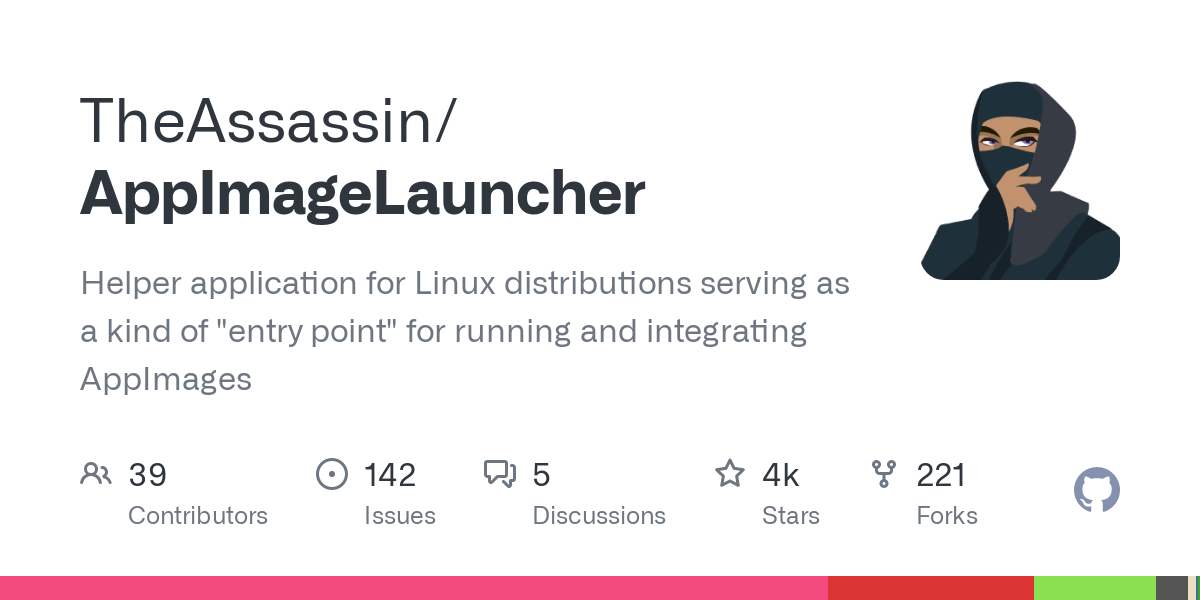I just found out about AppImageLauncher, a package handler for AppImages. It organizes them, creates desktop files for you and handles updates and removal.
Integrate AppImages to your application launcher with one click, and manage, update and remove them from there. Double-click AppImages to open them, without having to make them executable first.
Much better than having to create all the desktop files myself, and having to figure out what to put in them for it to work correctly (I’m looking at you, qBittorrent and magnet links).
Gear Lever is really cool as well: https://flathub.org/apps/it.mijorus.gearlever
deleted by creator
Looks like Gear Lever is more actively maintained too; thanks for sharing!
I love how gnome apps look so neat and simple. Never knew about this one. Thank you.
keep older versions installed or replace them with the latest release
This functionality does not seem to be present in AppImageLauncher.
deleted by creator
Good looking out. I installed this and verified it’s working, but does this automatically start at start up? I can’t seem to get systemctl enable to work on it.
deleted by creator
The best launcher you can get for AppImages is to just drop the thing and move to Flatpaks that don’t take 2 seconds to launch apps.
Some apps are only available as appimages.
Neverthrless you should ask the maintainer and work towards flatpaks.
As someone who tried to maintain a large application flatpak I would say it’s pain in the ass to work with and things break often. The way it’s configured and how permissions are set needs to be simplified.
Have you tried nix? I wonder if it works better.
Looking at you Bitwarden.
Appimage and snap. Why no flatpak?
There is a flatpak, but I’m pretty sure it’s a community version.
Appimage and snap. Why no flatpak?
I know why. They’re most likely running into this scenario as well.
The community flatpak of Bitwarden doesn’t have this issue.
Because it only lets you copy to the clipboard, lol.Because it only lets you copy to the clipboard, lol.
Fair enough. :P
Some apps are only available as appimages.
Yeah I know, I was just joking around, still AppImages are annoying.
Wait why is appimage bad
It’s not. These are opinions. Snap on the other hand… THAT is bad.
I can agree with that
From the “universal package formats” that’s the one I’ve had issues with when using it on a distro not specifically mentioned to work, it was supposed to be universal! Though not sure if that’s an issue with whoever packaged the app or anything specific with AppImage. Poor experience anyway.
Also no repo model. I like package manager to deal with shit. We have sorta solutions for that but not quite like snaps and flatpaks.
Also the dependencies stuff is weird. They advice you to think of the oldest (LTS?) distro you think the app will be used on and use deps compatible with that one. Which just seems, I dunno, icky, for lack of better word.
But for a random one-off app, I think it’s fine. I prefer flatpak but it’s fine, I wouldn’t avoid it or anything.
Ah ok. That makes sense. Thank you for taking the time to write out a long reply
It’s not.
Performance… or lack of it. Overhead.
This app is great, I’ve used it for a few months. I used to hate dealing with appimages, now I don’t even think about them.
Nope, no thank you… I’m not touching anything other than native, AUR or Flatpak packages. AppImage has only been an inelegant and overall inferior alternative in my experience. The Windows experience, with Linux portability issues. “Find an installer online from some website, have it do whatever the hell it wants, polluting my home folder with random crap and hope it’s not a virus” with essentially zero advantages over Flatpak or even Snap.
What makes Flatpak so good? Honest question. It is a new package manager for me, I have mostly been on Linux server, not desktop. For all my use cases Flatpak has never been mentioned, I’ve always used
apt-getuntil I installed Ubuntu as a desktop OS and it comes with Snap. The next thing I see is Flatpak > Snap and no mention ofapt-get.It’s not some miracle packaging system and while Flatpak-installed programs tend to start just as fast as native ones, I consider it inferior for most cases. Its two big advantages are that Flatpaks have a runtime they specify and depend on. It gets downloaded and installed automatically if missing when you install a Flatpak. So you’re much less likely to run into issues where a program won’t run on your system because of an incompatibility with a missing, or newer version of some library. Each Flatpak also gets installed in its own fake environment and is essentially a sandbox when you run the program. You can use a program named Flatseal to give each Flatpak access to specific directories or functionalities, or restrict it further. But the one big negative is that this runtime uses a lot of disk space. ~800MB per runtime.
It tends to work really well and I’ve been told that years ago a guy would use this packaging system to bundle pirated windows games with a preconfigured version of wine, which made them run out of the box, with zero tinkering. On top of essentially being sandboxed and unable to access your real home folder, internet, camera or microphone. Just to illustrate its versatility. It also kind of already won the war when Steam Decks started using Flatpak as their main packaging system.
It appears to be only desktop, what would explain why it is new to me despite being creating in 2007 (https://itsfoss.com/what-is-flatpak/, quick search).
Thanks for taking the time to explain. So from what I understand, it is a universal package manager (which
apt-getis not) and it is FOSS (which I understand Snap is not)?In brief yes, its newer then app image, and more open then snap.
I don’t remember anyone mentioning Snap being closed source, but it receives many complaints for interfering with the functioning of common programs, on top of slowing down the execution of programs installed through it and is now being forced on users. I haven’t touched any *buntu distro in years, but it always seemed half-baked from the comments I keep on reading about it.
Also yes, Flatpak is what I believe you could call a universal package manager. Package it once and it should run on any Linux distro since it takes most things out of the equation, save for the kernel and drivers. And yes, it mostly is used to distribute desktop applications. It’s ideal for safely running random applications or older programs that wouldn’t run through a modern runtime.
I read that Snap was propriety and a quick search did not give me any hits on their source code, but I could of course be wrong.
Never had it work right. 90% of the time it just prompts again or fails to run entirely.
Not sure if I’m using the same package or just a similar one. I’ve been annoyed at all the snaps, flatpacks, appimages, etc. for a while now. I just want to update from the repo and not end up with a bunch of slow, broken, poorly integrated alternatives on my computer. Being able to properly manage app images with a tool like this made the alternate distribution formats so much more tolerable. Now when I install something I pray that I’ll find an app image if it’s not in the repos!
I mostly used
apt-getbut when I installed Ubuntu as a desktop OS, I used their store until I understood that Snaps were not always the officially packaged versions. The same thing with Flatpaks. I wanted to install Sublime Text so I looked to Flathub and found a package by Sublime HQ Pty Ltd. Imagine my surprise when went to Sublimes own website to saw that they offer it viaapt-get(on Ubuntu/Debian), they even say on their forum that they do not provide via Flatpak or Snap.Someone just uploaded a package using a name that looks official, while not actually being the owner of the product.











